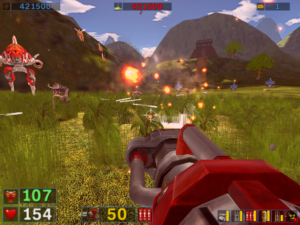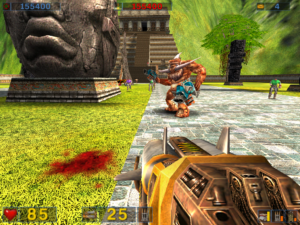SS2E: Scale and Chaos
 The Serious Sam engine was built to overwhelm the player with scale. The clipping plane (the horizon beyond which things don’t get rendered) is unusually far out, and may not even exist. There are exterior scenes of a size usually seen only in games containing vehicles. Often these areas have some kind of pyramid on the other side that turns out to be much larger and more distant than it looks, and I half suspect that the perspective is manipulated somehow to enhance this effect. Even the interiors are vast and cavernous: a rocket fired at the opposite wall of a chamber can sometimes take upward of thirty seconds to reach it. True, rockets in games aren’t as fast as they are in real life (you have to have an opportunity to dodge them, after all), but I’m not comparing this to the experience of firing a rocket across a room in real life, I’m comparing it to other games.
The Serious Sam engine was built to overwhelm the player with scale. The clipping plane (the horizon beyond which things don’t get rendered) is unusually far out, and may not even exist. There are exterior scenes of a size usually seen only in games containing vehicles. Often these areas have some kind of pyramid on the other side that turns out to be much larger and more distant than it looks, and I half suspect that the perspective is manipulated somehow to enhance this effect. Even the interiors are vast and cavernous: a rocket fired at the opposite wall of a chamber can sometimes take upward of thirty seconds to reach it. True, rockets in games aren’t as fast as they are in real life (you have to have an opportunity to dodge them, after all), but I’m not comparing this to the experience of firing a rocket across a room in real life, I’m comparing it to other games.
And all that space isn’t empty. The gameplay is designed to take advantage of it. They throw a lot of monsters at you at once, often from multiple directions. Some of them have ranged attacks that can kill you from very far away. More interestingly, some of them, such as the Kleer Skeleton, the Sirian Werebull, and the new monster in this installment, Cucurbito the Pumpkin, have difficulty stopping. These creatures charge at you, and when they miss (because you sidestepped at the last moment), they continue headlong until they can check their momentum. If you’re facing multiple opponents of this sort in an open area, they wind up scattering behind you in all directions, using more of the available space and increasing the chaos of battle.
This is a bigger deal than it sounds. In most FPS games, the most reliable general strategy is to take things slowly and clear out every area as you come to it, creating a safe area that you can fall back to if things get rough. The reason this works so well is that it all but guarantees that most enemies will be in front of you, where you can keep track of them and aim at them. A good FPS will employ tricks to keep this approach from working all of the time, but in Serious Sam, it fails most of the time without any need for special gimmickry. Screenshots just cannot do justice to the sense this creates of being attacked from all sides, and scrambling to pick off the most urgent threats from every direction at once.
 Comments(0)
Comments(0)